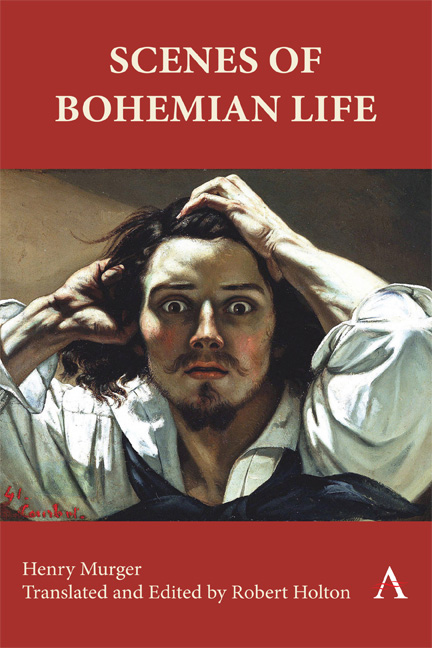Book contents
- Frontmatter
- Dedication
- Contents
- Introduction
- Chapter 1 How the Bohemian Society Was Established
- Chapter 2 A Gift from the Gods
- Chapter 3 Love at Lent
- Chapter 4 Ali-Rodolphe, or A Turk by Necessity
- Chapter 5 Charlemagne’s Coin
- Chapter 6 Mademoiselle Musette
- Chapter 7 The Sands of Pactolus
- Chapter 8 What Five Francs Can Cost
- Chapter 9 Polar Violets
- Chapter 10 The Cape of Storms
- Chapter 11 A Bohemian Café
- Chapter 12 A Reception in Bohemia
- Chapter 13 The Housewarming Party
- Chapter 14 Mademoiselle Mimi
- Chapter 15 Donec Gratus
- Chapter 16 The Passage of the Red Sea
- Chapter 17 The Graces Adorned
- Chapter 18 Francine’s Muff
- Chapter 19 Musette’s Whims
- Chapter 20 Mimi’s Fine Feathers
- Chapter 21 Romeo and Juliet
- Chapter 22 Epilogue to Love
- Chapter 23 Only Young Once
- Appendix: Murger’s Preface
- Notes
Appendix: Murger’s Preface
Published online by Cambridge University Press: 01 March 2024
- Frontmatter
- Dedication
- Contents
- Introduction
- Chapter 1 How the Bohemian Society Was Established
- Chapter 2 A Gift from the Gods
- Chapter 3 Love at Lent
- Chapter 4 Ali-Rodolphe, or A Turk by Necessity
- Chapter 5 Charlemagne’s Coin
- Chapter 6 Mademoiselle Musette
- Chapter 7 The Sands of Pactolus
- Chapter 8 What Five Francs Can Cost
- Chapter 9 Polar Violets
- Chapter 10 The Cape of Storms
- Chapter 11 A Bohemian Café
- Chapter 12 A Reception in Bohemia
- Chapter 13 The Housewarming Party
- Chapter 14 Mademoiselle Mimi
- Chapter 15 Donec Gratus
- Chapter 16 The Passage of the Red Sea
- Chapter 17 The Graces Adorned
- Chapter 18 Francine’s Muff
- Chapter 19 Musette’s Whims
- Chapter 20 Mimi’s Fine Feathers
- Chapter 21 Romeo and Juliet
- Chapter 22 Epilogue to Love
- Chapter 23 Only Young Once
- Appendix: Murger’s Preface
- Notes
Summary
The bohemians who are the subject of this book have nothing in common with those whom the boulevard playwrights have painted as thieves and murderers. They are not to be found among those who lead dancing bears, nor among sword-swallowers, those who buy and sell safety chains, the hawkers shouting Step right up! Everyone's a winner!, the dealers who swim in the shallow waters of loan-sharks or the thousand other mysterious and shadowy workers whose main work is to avoid all work, people who are always ready to do anything except what's right.
The species of bohemia at the heart of this book was not born today; it has existed always and everywhere and can stake a claim to illustrious origins. In ancient Greece, to trace the genealogy back no further, there was a famous bohemian who lived hand to mouth, trusting to fortune, traveling over the flowering countryside of Ionia, surviving on the bread of charity, and stopping in the evening by the hearth of hospitality to hang up his melodious lyre after singing the Loves of Helen and the Fall of Troy. As we descend the ladder of the ages, modern bohemia discovers its ancestors in every literary and artistic era. The Homeric tradition continues in the Middle Ages with the minstrels and the improvising actors, children possessing a joyful wisdom, all the musical vagabonds in the countryside of Touraine, all the wandering muses, with a beggar's bag of necessity on their shoulders alongside a troubadour's harp, singing as they crossed the plains of that beautiful land where the wild rose of Clemence Isaure was to bloom.
During the period of transition from the age of chivalry to the dawn of the Renaissance, bohemia races along the roadways of the kingdom and soon makes its appearance in the streets of Paris. Here we find the great Pierre Gringoire, a friend to beggars and bandits and an enemy to fasting, lean and hungry like a man whose whole life has been one long Lent.
- Type
- Chapter
- Information
- Scenes of Bohemian Life , pp. 225 - 232Publisher: Anthem PressPrint publication year: 2023

